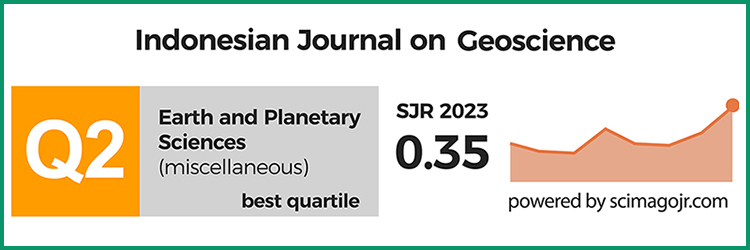Supergene Enriched, Intrusion Related Low Suphidation Deposit, Binebase-Bawone, North Sulawesi, Indonesia
DOI:
https://doi.org/10.17014/ijog.7.4.241-253Keywords:
supergene, enriched, intrusion, sulphidation, Binebase, BowmeAbstract
Gold mineralization at East Asia Minerals’ Binebase Prospect on Sangihe Island displays controls to mineralization typical of other Pacific Rim Intrusion related low sulphidation systems. Better gold grades are localized on EW dilatant structures at the intersection of NW trending structural corridors. Mineralization at Binebase was previously interpreted as being hosted in a high sulphidation style of alteration system. This assumption was based on surface observations of alunite and what was thought to be residual vuggy silica. Recent observations indicate that the alunite is a supergene mineral in nature and that the vuggy silica is the boxworked remnants of silica + pyrite alteration. Precious metal grades decline moving away from feeder structures and there has been significant supergene enrichment of gold in the oxide zone. Exploration drilling completed in 2008 by East Asia Minerals Indonesia resulted in an inferred resource of approximately 835,000 oz of contained gold at a cut off grade of 0.25 g/t Au. This resource included both oxide and hypogene sulphide mineralization. Drilling was reinitiated in 2011 to change the inferred to indicated resource, that drilling programme continued at the time of this publication. Various geophysical techniques were employed at both prospect and regional scales to aid exploration. Ground magnetics defined hydrothermal alteration and magnetite destruction which was coincident with mineralization at both Binebase and Bawone and an Induced Polarisation survey also produced an anomaly which was coincident with disseminated fine sulphide associated with clay alteration within the hydrothermal alteration. The southern part of the island was covered by an airborne geophysical survey in an attempt to understand the regional structural controls on mineralization and to define additional areas of hydrothermal alteration.
References
Arodji, W. and Johnnedy, S., 2009. Sangihe project 2008 exploration progress report. East Asia Minerals Corp. (unpublished).
Bautista, B., Indral, A., and Mappangara, A.L., 1998. Property Evaluation report, South. Sangihe Island, North Sulawesi, Indonesia. PT. Placer Mas Indonesia (unpublished).
Corbet, G., and Leach, T., 1995. Southwest Pacific Rim Gold-Copper Systems: Structure, Alteration and Mineralisation. Short course manual 5/95 edition.
Garwin, S.L., 1990. South Sangihe Regional Reconnaissance Programme. PT Meares Soputan Mining report no. MSM- TR/SLR/05/90.
Hamilton, W., 1979. Tectonics of the Indonesian region. USGS Professional Paper, 1078, Washington DC, 345pp. doi:10.1130/0016-7606(1988)100<1503:ptaia>2.3.co;2
Hamilton, W., 1988. Plate tectonics and island. arc. Geologial Society of America Bulletin, 100, p.1503-1527.
Stone, M., 2010. Independent Technical Report, Sangihe Property, Sangihe Island, North Sulawesi, Indonesia. Caracle Creek International Consulting. Unpublished company report.
Van den Bergh, G.D., De Voj, J., Azis, F., and Morwood, M.J., 2001. Elephantaidea in the Indonesian Region : new Stegodon findings from Flores. In: Cavaretta, G., Gioia, P., Mussi, M., and Palambo, M.R. (Eds.), The World of Elephants. Proceedings of the 1st International Congress, Rome 16 - 20 October, p.623-627.
Willianson-Jones, A.E., 2008. Report of 10645 Simon Fraser University. Research proposal.



















